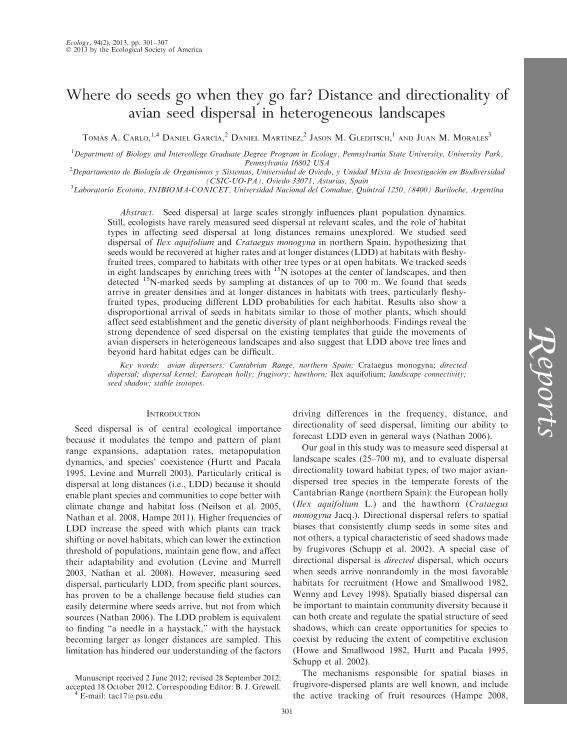Mostrar el registro sencillo del ítem
dc.contributor.author
Carlo, Tomás A.
dc.contributor.author
García, Daniel
dc.contributor.author
Martínez, Daniel
dc.contributor.author
Gleditsch, Jason M.
dc.contributor.author
Morales, Juan Manuel

dc.date.available
2016-07-26T20:38:56Z
dc.date.issued
2013-02
dc.identifier.citation
Carlo, Tomás A.; García, Daniel; Martínez, Daniel; Gleditsch, Jason M.; Morales, Juan Manuel; Where Seeds go when they go Far? Distance and Directionality of Avian Seed Dispersal in Heterogeneous Landscapes; Wiley; Ecology; 94; 2; 2-2013; 301-307
dc.identifier.issn
0012-9658
dc.identifier.uri
http://hdl.handle.net/11336/6713
dc.description.abstract
Seed dispersal at large scales strongly influences plant population dynamics. Still, ecologists have rarely measured seed dispersal at relevant scales, and the role of habitat types in affecting seed dispersal at long distances remains unexplored. We studied seed dispersal of Ilex aquifolium and Crataegus monogyna in northern Spain, hypothesizing that seeds would be recovered at higher rates and at longer distances (LDD) at habitats with fleshy-fruited trees, compared to habitats with other tree types, or at open habitats. We tracked seeds in eight replicate landscapes by enriching trees with 15N isotopes at the center of landscapes, and then detected 15N-marked seeds by sampling at distances of up to 700 meters. We found that seeds arrive in greater densities and at longer distances in habitats with trees, particularly fleshy-fruited types, which produced habitat-specific seed dispersal kernels (2Dt probability density functions). Results also show a disproportional arrival of seeds in habitats similar to those of mother plants, which can have important demographic consequences for seed establishment, such as Janzen-Connell effects, but also help decrease the genetic similarity of intraspecific neighborhoods. Findings reveal the strong dependence of seed dispersal on the templates that guide the movements of animal dispersers in heterogeneous landscapes.
dc.format
application/pdf
dc.language.iso
eng
dc.publisher
Wiley

dc.rights
info:eu-repo/semantics/openAccess
dc.rights.uri
https://creativecommons.org/licenses/by-nc-sa/2.5/ar/
dc.subject
Directed Dispersal
dc.subject
Invasions
dc.subject
Frugivory
dc.subject
Landscape Connectivity
dc.subject.classification
Ecología

dc.subject.classification
Ciencias Biológicas

dc.subject.classification
CIENCIAS NATURALES Y EXACTAS

dc.title
Where Seeds go when they go Far? Distance and Directionality of Avian Seed Dispersal in Heterogeneous Landscapes
dc.type
info:eu-repo/semantics/article
dc.type
info:ar-repo/semantics/artículo
dc.type
info:eu-repo/semantics/publishedVersion
dc.date.updated
2016-07-22T18:51:40Z
dc.journal.volume
94
dc.journal.number
2
dc.journal.pagination
301-307
dc.journal.pais
Estados Unidos

dc.journal.ciudad
Hoboken
dc.description.fil
Fil: Carlo, Tomás A.. State University Of Pennsylvania; Estados Unidos
dc.description.fil
Fil: García, Daniel. Universidad de Oviedo; España
dc.description.fil
Fil: Martínez, Daniel. Universidad de Oviedo; España
dc.description.fil
Fil: Gleditsch, Jason M.. State University Of Pennsylvania; Estados Unidos
dc.description.fil
Fil: Morales, Juan Manuel. Consejo Nacional de Investigaciones Científicas y Técnicas. Centro Científico Tecnológico Patagonia Norte. Instituto de Investigación en Biodiversidad y Medioambiente; Argentina
dc.journal.title
Ecology

dc.relation.alternativeid
info:eu-repo/semantics/altIdentifier/url/http://onlinelibrary.wiley.com/doi/10.1890/12-0913.1/abstract
dc.relation.alternativeid
info:eu-repo/semantics/altIdentifier/doi/10.1890/12-0913.1
dc.relation.alternativeid
info:eu-repo/semantics/altIdentifier/doi/http://dx.doi.org/10.1890/12-0913.1
Archivos asociados
